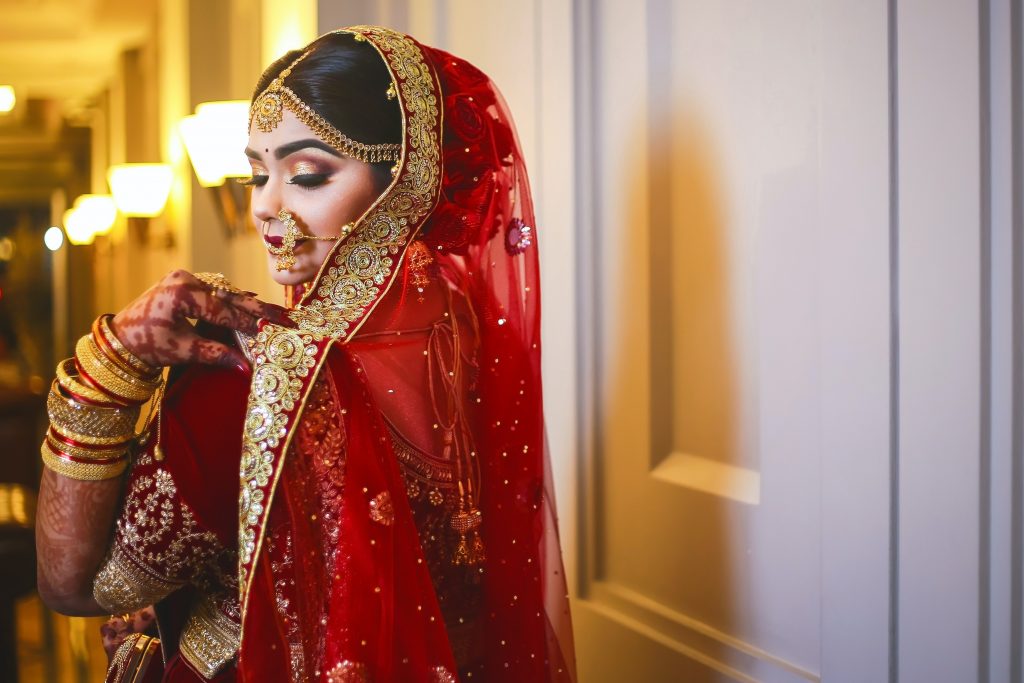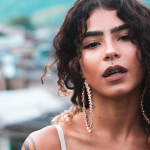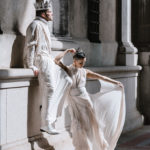Bridal fashion is much more than a white wedding dress for many. Cultures and religions across the world have quite varying ideas of what brides should be dressed in, and about what it means to look “bridal”.
Hindu bridal attire is one category of wedding fashion which is particularly interesting. Included in this, is the Solah Shringar – 16 ornaments which are mandatory for the bride to wear. Each item is significant for a different reason:
1. Bindi
A bride is adorned with a bindi which sits between her eyebrows. A round bindi is a symbol of married life. It also has religious implications.
2. Sindoor
This is a red coloured powder which completes the look of a bride and is applied to the parting of the hair. The colour symbolises marriage and the well-being of the groom.
The groom uses his thumb to apply the powder to his wife’s hair parting towards the end of the ceremony.
According to tradition, the wife should reapply this every morning for the rest of her married life.
3. Maang Tikka
The maang tikka is an ornament which is said to highlight the charm of a bride. Commonly made using gold and gems, it is worn on the head – on the central hair parting – and extends to the forehead. The item hangs over the “anja chakra”, which is the home of the body’s mind and intellect.
4. Kajal
Also known as Kohl, thid is applied on the edges of eyelids and is similar to eyeliner.
5. Nath
An accessory worn on the nose, the nath is another symbol of marriage. In some regions, this item is meant only for married women, who should wear it daily.
6. Haar
This necklace symbolises prosperity. At times, women replace a heavy piece of jewellery with a gift from her husband to be. This is called a Mangalsutra.
7. Karn Phool
These earrings are mandatory for the bride. They are often quite large and heavy and thus are supported using the brides hair.
8. Mendhi
Women apply mendhi or henna to their hands. The designs are symbolic of celebrations, and the colour (maroon) is believed to be auspicious and to signify a variety of things from the love between the pair getting married to wealth and fertility.
Some say that the darker the mendhi the stronger the love is from the groom to the bride.
9. Choodiyan
Bangles are also compulsory for the bride. They symbolise prosperity and a long life for the groom. Designs vary between communities, however they are most commonly red and made using gold, glass, or metal.
10. Baajuband
Worn on the upper arm, the armlet is made using gold or silver and may be decorated with pearls or gems. This item is believed to fight away evil spirits.
11. Aarsi and Haathphool
The aarsi is a thumb ring which has a mirror set on it. This allows the bride to get a glimpse of her soon-to-be husband, since tradition states that the bride should not see her groom before and for a large part of the ceremony.
Haathphool is a set of 8 rings which are worn on both hands.
12. Keshapasharachana
A hair accessory, consisting of gold ornaments and flowers, which is commonly used to decorate a braid or bun.
13. Kamarband
This item is a gold waistband which is used to highlight the shape of the brides silhouette and to assist with keeping the dress or sari in place.
14. Payal
Said to signify the Goddess Lakshmi, these anklets look beautiful and create a melodious sound. It is commonly a chain tied around the ankle which has little bells attached to it.
15. Itar
While not a physical item, the perfume complements the Solah Shringar.
16. Shaadi ka Joda
The bridal dress is commonly a bright colour such as red, maroon, green, or gold and is embroidered from head to toe. The dress itself can be a sari, a lehnga, or salwaar kameez, depending on the region of India where the bride’s family is from.
Lehnga:
Sari:
Salwaar Kameez:
Image: Pexels




 . FOLLOW, SHARE, LIKE, & COMMENT,
. FOLLOW, SHARE, LIKE, & COMMENT, 
 @fashion1idea4 @fashion1idea4 #makeup, #beautybloggers, #jewellery , #jwellery, #jwellery, #jewellerydesign, #mangtikka, #mangtikkalove,, #beautifuldulhan , #jewellery, #jewellery_blog
@fashion1idea4 @fashion1idea4 #makeup, #beautybloggers, #jewellery , #jwellery, #jwellery, #jewellerydesign, #mangtikka, #mangtikkalove,, #beautifuldulhan , #jewellery, #jewellery_blog 
 Style
Style Mua @anju_lamba13 #aslovich #bhupinderahuja #smokeyeye #smokeymakeup #kohl #eyemakeupgoals #eyeshadowlooks #jewelry #weddingseason #weddingtrends #weddingphotography #weddinghair #makeupgoals #makeupinspo #boldlips #hairstyling #hairtransformation #hdmakeup #airbrushmakeup #bridalmua #delhimakeupartist #contouring #contouringmakeup #blousedesign
Mua @anju_lamba13 #aslovich #bhupinderahuja #smokeyeye #smokeymakeup #kohl #eyemakeupgoals #eyeshadowlooks #jewelry #weddingseason #weddingtrends #weddingphotography #weddinghair #makeupgoals #makeupinspo #boldlips #hairstyling #hairtransformation #hdmakeup #airbrushmakeup #bridalmua #delhimakeupartist #contouring #contouringmakeup #blousedesign
 #traditionalearrings #traditionalnath #pune #delhi #bangalore #chennai
#traditionalearrings #traditionalnath #pune #delhi #bangalore #chennai Aarsi ring or Darpan as you may call it…worn originally by the Queen's on their thumbs or forefinger, was designed so that the bride would secretly catch the glimpse of her groom, as the face of the bride used to be covered with a veil! A circular mirror, embedded by a beautiful intricately carved pattern in 92.5 Sterling Silver, holds a special place in every woman's heart, so that she descretely check if her hair & make-up are in place…
Aarsi ring or Darpan as you may call it…worn originally by the Queen's on their thumbs or forefinger, was designed so that the bride would secretly catch the glimpse of her groom, as the face of the bride used to be covered with a veil! A circular mirror, embedded by a beautiful intricately carved pattern in 92.5 Sterling Silver, holds a special place in every woman's heart, so that she descretely check if her hair & make-up are in place… Simplicity in its own
Simplicity in its own


 Complete your #BRIDALWEARGOALS by wearing this #exquisite royal maroon color velvet #lehenga set for just
Complete your #BRIDALWEARGOALS by wearing this #exquisite royal maroon color velvet #lehenga set for just  Rs 3990/-
Rs 3990/-  Whatsapp us on +91 7575882020 to place your order or click web link @ethnicplus.in
Whatsapp us on +91 7575882020 to place your order or click web link @ethnicplus.in  Original!
Original! 
 Worldwide Shipping
Worldwide Shipping  Custom Size Stitching available
Custom Size Stitching available Comment down “
Comment down “ ” if you do
” if you do  Me as a bride
Me as a bride  Makeup by me
Makeup by me  . . #bridalshoot #bride #bridalmakeup #bridalsari #bridenepal #red #PGglam #pgglambridals #pgglammakeup @nepalibrides @nepali_culture @prb.bridal #muanepal #nepalibride
. . #bridalshoot #bride #bridalmakeup #bridalsari #bridenepal #red #PGglam #pgglambridals #pgglammakeup @nepalibrides @nepali_culture @prb.bridal #muanepal #nepalibride
















